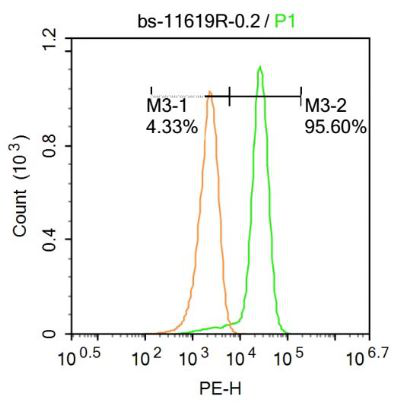产品货号 : mlR11619
英文名称 : RTP3
中文名称 : 受体转运蛋白3抗体
别 名 : LTM1; Receptor (chemosensory) transporter protein 3; Receptor transporter protein 3; Receptor-transporting protein 3; RTP3; RTP3_HUMAN; TMEM7; Transmembrane protein 7.
研究领域 : 神经生物学 细胞膜受体 转运蛋白
抗体来源 : Rabbit
克隆类型 : Polyclonal
交叉反应 : Human, Mouse,
产品应用 : WB=1:500-2000 ELISA=1:500-1000 Flow-Cyt=0.2ug/test
not yet tested in other applications.
optimal dilutions/concentrations should be determined by the end user.
分 子 量 : 27kDa
细胞定位 : 细胞膜
性 状 : Lyophilized or Liquid
浓 度 : 1mg/ml
免 疫 原 : KLH conjugated synthetic peptide derived from human RTP3:21-120/232
亚 型 : IgG
纯化方法 : affinity purified by Protein A
储 存 液 : 0.01M TBS(pH7.4) with 1% BSA, 0.03% Proclin300 and 50% Glycerol.
保存条件 : Store at -20 °C for one year. Avoid repeated freeze/thaw cycles. The lyophilized antibody is stable at room temperature for at least one month and for greater than a year when kept at -20°C. When reconstituted in sterile pH 7.4 0.01M PBS or diluent of antibody the antibody is stable for at least two weeks at 2-4 °C.
PubMed : PubMed
产品介绍 : Members of the RTP (receptor transporter proteins) family have recently been discovered to influence bitter taste receptor expression in addition to inducing the expression of mammalian odorant receptors. RTP3 is a 232 amino acid single-pass type III membrane protein belonging to the TMEM7 family. Unlike other RTP proteins, RTP3 is not expressed in olfactory neurons but is expressed predominantly in liver. RTP3 is involved in the functional expression of bitter taste receptors and suppresses cell proliferation, and is also found in human circumvallate papillae and testis (regions where bitter taste receptors are expressed). The gene encoding RTP3 maps to human chromosome 3p21.31 within C3CER1 (chromosome 3 common eliminated region 1), which is frequently eliminated in chromosomal deletions of solid tumors.
Function:
Expressed predominantly in the liver.
Subcellular Location:
Membrane; Single-pass type III membrane protein
Tissue Specificity:
Belongs to the TMEM7 family.
Similarity:
Belongs to the TMEM7 family.
SWISS:
Q9BQQ7
Gene ID:
83597
Important Note:
This product as supplied is intended for research use only, not for use in human, therapeutic or diagnostic applications.
产品图片












